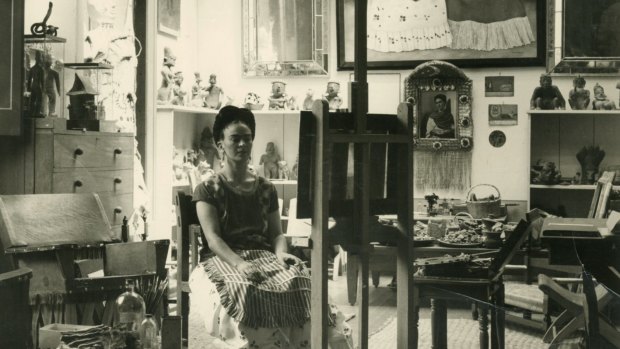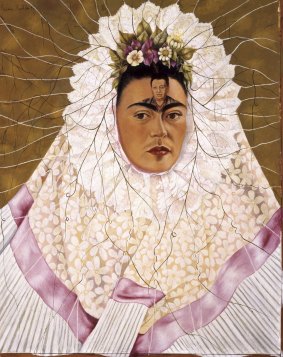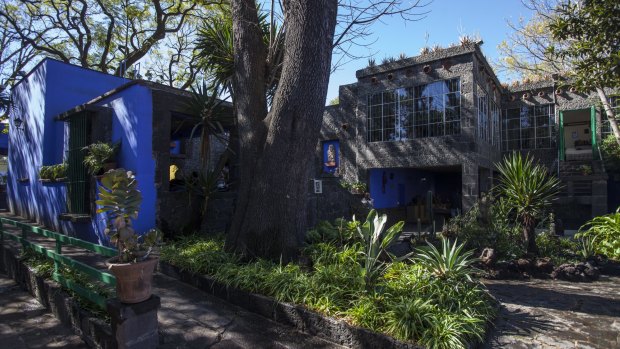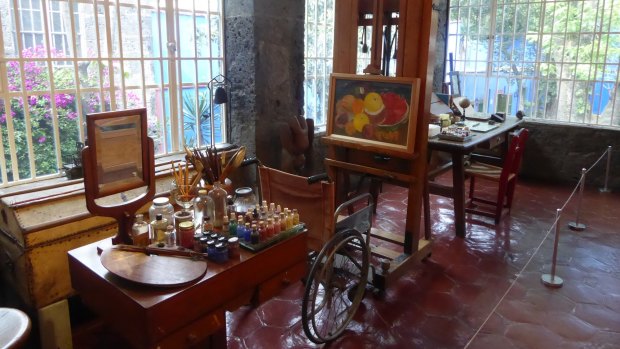This was published 7 years ago
Frida Kahlo museum, Mexico City: Inside the home of Frida Kahlo
By Sue WIlliams

Frida Kahlo in her studio in the early 1940s.Credit: Art Gallery of NSW
There is a flutter of brilliant blue butterflies under the canopy of the bed Mexican artist and style icon Frida Kahlo slept in for much of her life in her home in the southern suburbs of Mexico City.
The framed collection was a gift from one of her many admirers, American artist Isamu Noguchi, and she loved it, her friends said, because she could gaze at them as she fell asleep and dream of the joy of flight, of freedom, of life without boundaries – despite being trapped, exhausted, in a body constantly wracked with pain.
And, in turn, Noguchi loved her too. Indeed, his time with her in that very bed was only interrupted by a warning from her houseboy that her husband, fellow artist Diego Rivera, was on his way. The terrified lover managed to escape in time by climbing out of the window, but not before one of Kahlo's dogs seized a sock. Later, Rivera paid Noguchi a visit with that sock … and a gun.

Frida Kahlo's Diego on my mind (self-portrait as Tehuana) 1943.Credit: Art Gallery of NSW
It was simply one dramatic episode in the immensely colourful life of Mexican painter Kahlo. Wandering in her footsteps around the Casa Azul in Coyoacán where she was born and where, just 47 years later, she died, suddenly her life makes so much more sense.
Many of us know that the woman who lived so much in Rivera's shadow during her lifetime but who's since become an internationally-acclaimed figure, was a magnificent artist who battled injury and anguish all her life.
But it's something you can't properly appreciate until you too can contemplate those butterflies, or you catch sight of the daybed to which she retreated every afternoon when the pain and drugs overwhelmed her, or you see her paints and her easel in her studio with a wheelchair drawn up close.

The Frida Kahlo museum.Credit: Miguel Tovar
Her exquisite art, her eye for colour and her flamboyance become even more remarkable when you see, first-hand, how painful and difficult her life was, especially with the display of the monstrous support garments – like the steel corset – she had to wear to keep herself upright and working.
That reality is a great counterpoint to the fresh round of Frida Fever that's about to engulf us as a new exhibition on Kahlo and Rivera gets set to open in the Art Gallery of NSW on June 25. With 40 artworks from Eastern European collectors Jacques and Natasha Gelman, it also includes some of Kahlo's most famed self-portraits, like Diego on my Mind, Love Embrace of the Universe and Self-Portrait with Monkeys, and photographs of her, and Rivera.
For those who've already visited Kahlo's museum in Mexico, it's likely to be a poignant revisiting of a tortured life crammed with evocative, and eccentric, works. But for those who've not yet been, it will certainly whet the appetite for what is always an absolute highlight of any trip to Mexico: an opportunity to take a closer look at both her life, and, yes, her death in 1954. Her ashes lie in a decorative pre-Columbian urn on a side table, next to her funeral mask.

Inside the Museo Frida Kahlo.Credit: Jimmy Thomson
The museum in her former home in Mexico City tells her story from her birth there in 1907 – even though she claimed, romantically, that she was born in 1910, the start of the Mexican Revolution – the bout of childhood polio at age six that left one leg permanently thinner and weaker than the other, and then the terrible bus accident when she was 18 that broke her shoulder, leg, pelvis and ribs, leaving her stomach pierced and her womb damaged.
Those events blighted her entire life. Originally, she was going to be a doctor or nurse as one of that first generation of women in Mexico to win a place at medical school, but the accident left her health too compromised to continue. Instead, she poured much of her suffering into her painting as an escape from her own reality.
Everything comes to life in that house today, with its striking blue walls and traditional courtyard at its centre. In her day, it was a place she entertained myriad famous visitors from all over the world, including US vice-president Nelson Rockefeller, composer and pianist George Gershwin, Soviet revolutionary Leon Trotsky and Hollywood star Dolores del Río.
Scattered throughout the house are plenty of Kahlo's own artworks, as well as her personal art collection, including examples of the 2000-plus votive cards she and Rivera gathered. Mexicans who had survived some accident or serious illness used to commission artists to portray them in a melodramatic rendering of their misfortune, often with a guardian angel added, and they'd then place them in their churches as thanks for their survival.
There are also notes and photographs Kahlo kept around her, while there is also her wardrobe of folk dresses that became her trademark, and a collection of her fabulous over-the-top jewellery and glasses.
Despite her artistic, Bohemian, feminist cult following, Kahlo was also a domestic goddess. The sunflower yellow and blue traditionally Mexican kitchen and dining room are equipped with earthenware pots and pans and decorated glassware and plates that wouldn't look out of place in a contemporary kitchen. Mind you, perhaps the papier-mache Judas skeletons dangling from the ceiling might …
Her bedroom is perhaps the most fascinating room of all, however. After her accident, she spent two years in bed, recovering – she underwent an estimated 35 operations in total – and it later became the room she mostly shared with Rivera.
She'd met him as an arts student while he was working on his famed murals at the Secretaria de Educacion Publica building in 1927. She invited him to the Caza Azul to see her work and shortly afterwards declared she was in love and wanted to marry him, despite being 20 years younger, much to the horror of her friends and family.
But marry him she did in 1929, and they stayed together, admittedly in a bohemian open relationship, until their divorce in 1939, prompted by his affair with her younger sister. The next year, they remarried and continued together until her death, although their relationship was still punctuated by lovers. Noguchi was one of many. Perhaps her best known dalliance was with Trotsky, who came to stay at the house while seeking political asylum during Stalin's reign. He and his wife later moved out to a house nearby.
Kahlo's bed today is no less colourful. At the head is a painting of a dead child, a reminder of her many miscarriages and misery at being unable to have her own child. At its foot is an expression of her communist beliefs, with pictures of Stalin, Lenin, Marx, Engels and Mao Zedong. Trotsky was expunged when, despite their affair, both she and Rivera switched their loyalties to Stalin.
There's also a mirror suspended from the canopy so she could paint self-portraits while lying down, and her pillow is embroidered with perhaps the most poignant message of all. 'Do not forget me, my love', it reads.
No one could forget her, of course, and her Casa Azul has become one of the most visited museums in Mexico City.
Qantas flies direct to Dallas, then American Airlines flies to Mexico City. Australians require US travel authorisation before departure (see www.esta.cbp.dhs.gov), but a tourist card to enter Mexico is issued at the airport.
STAYING THERE
Holiday Inn Mexico Coyoacan, Calzada de Tlalpan 1507, Benito Juárez, Portales Norte, 03300 Ciudad de México. See www.ihg.com
SEE + DO
Mexico has a great metro system, with a station at Coyoacan, and other nearby stations at Viveros and General Anaya. The Museo Frida Kahlo, Londres 247, is open from 11am-5.30pm Tuesdays and 10am-5.20pm Wednesdays to Sundays. Admission is $6 (80 pesos) and a photography permit costs an extra $3.
KAHLO IN SYDNEY
The Art Gallery of NSW will hold an exhibition of works by Frida Kahlo and Diego Rivera from the Jacques and Natasha Gelman Collection from June 25 to October 9.
Sue Williams travelled at her own expense.
FIVE THINGS NOT TO BE MISSED NEARBY
LEON TROTSKY'S HOUSE
Trotsky's desk has been left exactly the way it was, with his glasses and a book open, when his assassin came from behind and plunged an ice axe into his skull. Adding to the atmosphere are the windows blocked up in the vain attempt to protect him after Stalin declared the death sentence, and bullet holes in the bedroom from a previous failed murder attempt.
MUSEO NACIONAL DE CULTURAS POPULARES
A cheerier destination for its exhibitions of folk art, dance and crafts.
COYOACÁN CENTRAL PLAZAS
Daily markets at the Plaza Hidalgo and adjacent Jardin Centenario, with its coyote fountain, are a cut above anything you'll find in the city. There are wonderful handicrafts, quality souvenirs, colourful clothes, music and artists painting and selling their wares.
CHURROS RELLENOS CAFETERIA DE COYOACÁN
Quite possibly the most famous, and most loved, churros shop in the whole of Mexico. Unlike most churros – long stick sugared doughnuts you dip in crème de leche or chocolate – these actually come filled with deliciously oozing centres.
DIEGO RIVERA ANAHUACALLI MUSEUM
This was designed by Rivera to house his pre-Hispanic art collection and is a great place to view some of his work. Other musts to view his stunning murals are the Secretaria de Educacion Publica, the Museo Diego Rivera, the Museo de Arte Moderno and the Museo Dolores Olmeda.
Sign up for the Traveller Deals newsletter
Get exclusive travel deals delivered straight to your inbox. Sign up now.